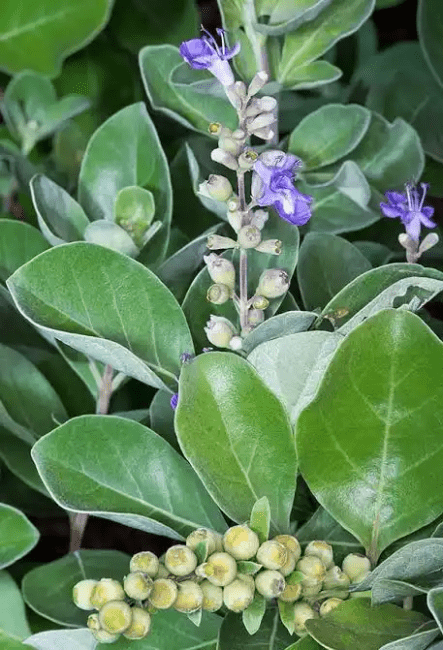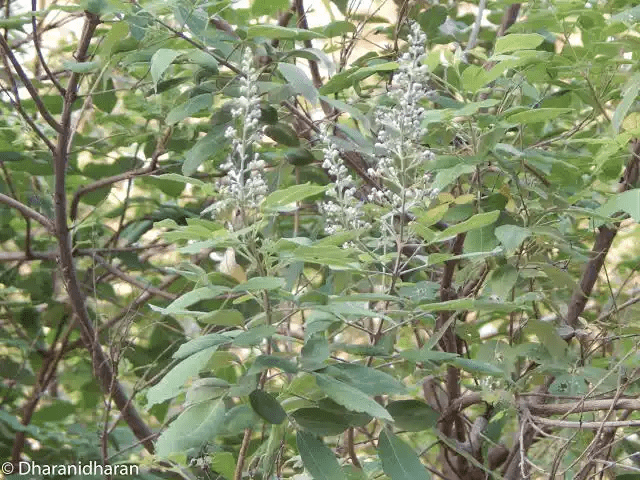The Indian Chaste Tree, scientifically known as Vitex trifolia, is a versatile and valuable plant found across various tropical and subtropical regions of Asia, Australia, and the Pacific Islands. This species, a member of the Verbenaceae family, is renowned for its diverse uses in traditional medicine, horticulture, and even folklore.
Characterized by its fragrant, lilac-colored flowers and palmate leaves with three to five leaflets, Vitex trifolia is a deciduous shrub or small tree that typically grows in coastal areas, scrublands, and disturbed habitats.
In traditional medicine systems like Ayurveda and traditional Chinese medicine, different parts of the Indian Chaste Tree have been used for their purported medicinal properties.
The plant’s berries, leaves, and roots have been employed to address various health concerns, including menstrual disorders, inflammation, digestive issues, and as a general tonic.
The plant’s compounds, particularly flavonoids and terpenoids, are believed to contribute to its therapeutic potential.
One of its common names, the Chaste Tree, hints at its historical use as a traditional remedy to support women’s health, particularly in managing menstrual irregularities and promoting hormonal balance. However, scientific evidence supporting these traditional uses is still being explored and researched.
In addition to its medicinal uses, Vitex trifolia has ornamental value and is cultivated in gardens and landscapes for its attractive flowers and foliage. Its adaptability to different soil types and climates makes it a favored choice for landscaping in tropical and subtropical regions.
Conservation efforts for Vitex trifolia are crucial, especially considering the pressure from habitat loss due to urbanization and agricultural expansion.
Protecting its natural habitats and promoting sustainable cultivation practices can help ensure the preservation of this species and its potential benefits for both traditional medicine and horticulture.
The Indian Chaste Tree, with its historical significance in traditional medicine, ornamental appeal, and ecological role, remains a plant of interest for researchers, herbalists, and gardeners alike, contributing to the rich tapestry of botanical diversity in its native regions.
The Botanical Description of Vitex trifolia
1. Life: Vitex trifolia, commonly known as Indian Chaste Tree or Simpleleaf Chaste Tree, is a deciduous shrub belonging to the Verbenaceae family. This versatile plant is valued for both its ornamental and medicinal properties.
2. Appearance: The shrub typically reaches a height of about XX meters and features palmately compound leaves, with usually three to five leaflets. The arrangement of these leaves creates an attractive and distinctive appearance, making it a popular choice in gardens and landscapes.
3. Flowers: The flowers of Vitex trifolia are noteworthy for their tubular shape and range in color from lavender to blue. They are borne in panicles, contributing to the plant’s overall aesthetic appeal. Understanding the botanical features enhances our appreciation for the beauty and diversity of this species.
The Geographic Distribution of Vitex trifolia
1. Natural Habitat: Vitex trifolia is native to a wide range of regions, including Southeast Asia, Australia, and the Indian subcontinent. It thrives in a variety of habitats, from coastal areas to open woodlands, showcasing its adaptability to different environmental conditions.
2. Range: The geographic distribution of Vitex trifolia extends across tropical and subtropical regions, where it often finds a home in well-drained soils. Its presence in diverse climates underlines its ability to flourish in various ecosystems.
3. Ecological Significance: Understanding the geographic distribution of Vitex trifolia is essential for recognizing its ecological role. The shrub provides habitat and food for various insects and birds, contributing to the biodiversity of the areas it inhabits.
The Chemical Composition of Vitex trifolia
1. Active Compounds: Vitex trifolia is known for its diverse chemical composition, including flavonoids, terpenoids, and essential oils. These compounds contribute to the plant’s medicinal properties and are of interest in pharmaceutical and traditional medicine research.
2. Medicinal Properties: The active compounds in Vitex trifolia have been linked to various medicinal benefits. Traditionally, parts of the plant have been used to address conditions such as inflammation, hormonal imbalances, and menstrual disorders. Ongoing research seeks to validate these traditional uses and explore new therapeutic applications.
3. Research and Applications: Continued exploration of the chemical composition of Vitex trifolia opens avenues for potential applications in medicine and other industries. As we delve deeper into the synergies of its compounds, new insights may emerge, offering opportunities for pharmaceutical development and further understanding of the plant’s ecological role.
Read Also: How to Farm and Care for American Sea Scallop (Placopecten magellanicus)
The Medicinal Health Benefits Of Vitex trifolia (Indian Chaste Tree)

1. Hormonal Balance: Vitex trifolia supports hormonal balance in both men and women, regulating the endocrine system for conditions related to hormonal imbalances.
2. Menstrual Disorders: Alleviates symptoms of menstrual disorders, including irregular periods, premenstrual syndrome (PMS), and discomfort.
3. Fertility Support: Supports fertility by promoting a healthy balance of reproductive hormones, aiding couples trying to conceive.
4. Stress and Anxiety Relief: Acts as an adaptogen, assisting the body in coping with stress and reducing anxiety and stress-related symptoms.
5. Anti-inflammatory Effects: Contains compounds with anti-inflammatory properties, beneficial for joint pain and inflammatory skin conditions.
6. Headache and Migraine Relief: Traditionally used for alleviating headaches and migraines, providing relief through its soothing effects on the nervous system.
7. Skin Conditions: Offers benefits for certain skin conditions through its anti-inflammatory and antioxidant properties.
8. Respiratory Health: Used to address respiratory conditions, potentially supporting respiratory health and easing associated symptoms.
9. Anti-microbial Properties: Contains compounds with potential antimicrobial properties, used in traditional remedies for infections.
10. Digestive Support: Provides digestive benefits, relieving indigestion and bloating, and promoting a healthy digestive system.
11. Anti-cancer Potential: Research suggests potential anti-cancer properties, although further studies are needed for validation.
12. Cardiovascular Health: Contributes to cardiovascular health by positively influencing factors such as blood pressure and cholesterol levels.
13. Anti-diabetic Effects: Indicates potential anti-diabetic properties, aiding in the management of blood sugar levels.
14. Anti-oxidative Benefits: Contains antioxidants that neutralize free radicals, contributing to overall health and well-being.
The Methods of Usage to Achieve the Provided Health Benefits Of Vitex trifolia (Indian Chaste Tree)
1. Herbal Infusions: Consume herbal infusions of Vitex trifolia leaves regularly for hormonal balance and menstrual health.
2. Tinctures: Use tinctures made from Vitex trifolia extracts to support fertility and hormonal health, as directed by healthcare professionals.
3. Topical Applications: Apply creams or ointments with Vitex trifolia extracts topically for skin conditions and localized benefits.
4. Dietary Supplements: Incorporate Vitex trifolia supplements in capsule or tablet form into your routine, especially for hormonal balance.
5. Aromatherapy: Inhale the aroma of Vitex trifolia essential oil through diffusers or diluted applications on pulse points for stress relief.
6. Culinary Use: Use certain parts of Vitex trifolia in culinary practices for a flavorful way to enjoy potential health benefits.
The Side Effects Of Using Vitex trifolia Medicinal Plant
1. Gastrointestinal Upset: Excessive consumption may lead to nausea or stomach discomfort; follow recommended dosages.
2. Allergic Reactions: Exercise caution if allergic to plants in the Verbenaceae family to avoid possible allergic reactions.
3. Interaction with Medications: Consult healthcare professionals as Vitex trifolia may interact with certain medications, particularly those affecting hormonal regulation.
4. Hormonal Effects: Proper dosing is crucial, as excessive use may have unintended effects on hormonal balance.
5. Pregnancy and Breastfeeding: Pregnant and breastfeeding individuals should avoid use without consulting healthcare providers due to potential effects on hormones.
6. Not for Everyone: Individual responses vary, requiring monitoring for both positive effects and potential adverse reactions.
7. Potential Drug Interactions: Inform healthcare providers of any herbal supplements, especially if on prescription medications.
8. Headaches: Monitoring for headaches as a potential side effect is recommended.
9. Sleep Disturbances: Changes in sleep patterns may occur; monitor responses, especially when using for stress relief.
10. Dizziness: Excessive consumption may lead to dizziness; use cautiously and discontinue if adverse effects occur.
Read Also: 6 Health Benefits of Fennel (Foeniculum vulgare)
The Scientific Research and Studies of Vitex trifolia

1. Phytochemical Analysis: Scientific studies on Vitex trifolia focus on its phytochemical composition, exploring compounds like flavonoids, terpenoids, and essential oils. Researchers aim to identify and understand the potential therapeutic properties of these compounds.
2. Medicinal Applications: Research looks into the medicinal applications of Vitex trifolia. Studies investigate its potential as an anti-inflammatory, analgesic, and its role in hormonal balance, shedding light on its traditional uses.
3. Pharmacological Studies: Scientific investigations explore the pharmacological effects of Vitex trifolia extracts. Studies aim to validate its effects on various physiological pathways, providing insights into its mechanisms of action.
The Safety Precautions and Recommendations In Using Vitex trifolia Medicinal Plant
1. Consultation: Before using Vitex trifolia medicinally, consult a qualified healthcare professional or herbalist to understand potential risks and proper usage.
2. Dosage Control: Adhere strictly to recommended dosages. Excessive consumption may lead to adverse effects.
3. Allergic Reactions: Be cautious of potential allergic reactions. Some individuals may experience allergies to certain components of Vitex trifolia.
4. Pregnancy and Lactation: Avoid use during pregnancy or lactation unless advised by a healthcare provider due to potential risks.
5. Interaction with Medications: Check for potential interactions with existing medications before using Vitex trifolia to prevent adverse effects or reduced efficacy of medications.
6. Harvesting Practices: If harvesting the plant, do so sustainably and ethically to preserve the species and its habitat.
7. Mental Health Considerations: Exercise caution due to the psychoactive properties of certain compounds in Vitex trifolia, especially if dealing with mental health conditions.
8. Children’s Use: Keep Vitex trifolia out of reach of children. Its effects on children are not well-studied and may pose risks.
9. Medical Conditions: Individuals with specific medical conditions, such as hormone-sensitive conditions, should use Vitex trifolia cautiously or avoid it altogether.
10. Side Effects Monitoring: Be vigilant for any side effects or adverse reactions while using Vitex trifolia and seek medical attention if needed.
11. Long-term Use: Prolonged or excessive use of Vitex trifolia may have unknown long-term effects. Use with caution and moderation.
FAQs About Vitex trifolia Medicinal Plant
1. Is Vitex trifolia safe for consumption?
Yes, when used appropriately and in moderation. However, consult a healthcare professional for guidance.
2. What are the known side effects of using Vitex trifolia?
Possible side effects include gastrointestinal discomfort and allergic reactions in some individuals.
3. Can Vitex trifolia be used during pregnancy?
It’s not recommended during pregnancy due to potential risks. Consult a healthcare provider for advice.
4. Does Vitex trifolia interact with medications?
It may interact with certain medications. Consult with a healthcare professional before use.
5. What is the recommended dosage of Vitex trifolia?
Dosage varies and should be determined by a qualified practitioner.
6. Can Vitex trifolia be used for mental health purposes?
Some compounds have psychoactive properties; caution is advised, especially for mental health concerns.
7. Is it safe for children to use Vitex trifolia?
Its effects on children are not well-understood; keep it away from children.
8. How should Vitex trifolia be harvested sustainably?
Ethical and sustainable harvesting practices help preserve the species and its habitat.
9. Are there specific medical conditions that contraindicate the use of Vitex trifolia?
Individuals with hormone-sensitive conditions should use it cautiously.
10. Can Vitex trifolia cause allergic reactions?
Some individuals may be allergic to components of Vitex trifolia.
Read Also: Farming Tractor Operation Guide

